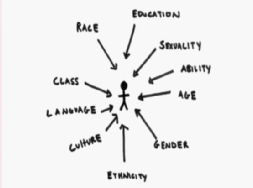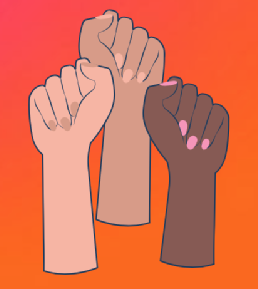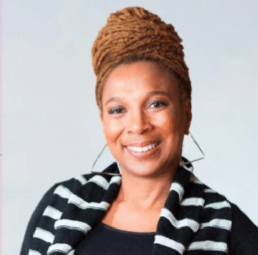Marginalised Voices: A study of intersectional feminism in performative spaces
About Our Project:
This interdisciplinary research project focuses on the representations and experiences of intersectional feminism within performative spaces. Looking at how performance can be a way of engaging directly with social reality, not just as a medium but also as a means to pose questions about how art relates to the wider social world.
Problématique
How feminist ideals and experiences have been represented in film and theatre, in terms of content and participation, and how these practices have evolved, in the context of a changing socio-political environment.
Corpus
This project is led by 4 researchers and each of us will be focusing on a specific cultural context, one that we personally connect with. These include black female representation, theatre in India, queerness in early modern drama, and trans women studies, across film plays and texts.
Output
We will be creating a range of outputs on our specific cultural contexts from leaflets to presentations, then coming together in a final podcast, in which we will each talk about our specific area of research, in an informal, conversational setting and bring in our respective interviews, and discussions.
Researchers: Brinta Mutinda (UG), Tijen Mustafa (UG), Ahana Mitra (UG) and Eve Davis (UG)
What is intersectional feminism?
Intersectional feminism is a framework used to ask questions about the oppression of women, or the construction of the patriarchy: these distinct lenses through which we look at feminism could be race, age, sexuality etc.
- Kimberlé CrenshawLink opens in a new window, an American law professor who coined the term in 1989 explained Intersectional feminism as, “a prism for seeing the way in which various forms of inequality often operate together and exacerbate each other,” in a recent interview with TimeLink opens in a new window.
- “All inequality is not created equal,” she says. An intersectional approach shows the way that people’s social identities can overlap, creating compounding experiences of discrimination.
- Intersectional feminism centres on the voices of those experiencing overlapping, concurrent forms of oppression in order to understand the depths of the inequalities and the relationships among them in any given context.
Black Female Representation in Film and TV
The representation of Black women in film and tv has increased significantly in recent years. Because of the tireless effort of Black women within the entertainment industry, black feminist activists, and recent social movements.
Despite recent progress in the representation of Black women within film and tv, the entertainment industry still has a long way to go, specifically in terms of the representation of different types of Black women and the representation of Black women in front and behind the camera.
The article linked below takes a deep dive into the representation of Black women in film and tv throughout the ages, exploring how far the industry has come in regards to the increase of black female representation and the factors that contributed to this change over time. As well as discussing areas of representation of black women in film and tv that remain unrepresented and ways in which the entertainment industry needs to change.
Emilia, by Warwick Shakesoc 2022
Feminism and Queerness in Early Modern Drama
Early modern drama or theatre roughly includes plays performed between 1576 – 1642 and for many of us our first introduction is in childhood, mostly in the form of animated Shakespeare plays in school, then study in every year of the curriculum following. However, regardless of many of the plays being steeped in crossdressing, people falling in love, and adaptations leaning into the ‘queerer aspects’ it is not until university that I first heard explicitly of how ‘queer’ some of these plays really are, or at least can be perceived to be. Equally playwriters from Lyly to Shakespeare perhaps surprisingly write of feminine power and influence ahead of their time, their female characters are often vital to the plot, autonomous, and outspoken just as their male characters are. During school we often had lessons centred around the question ‘was Shakespeare a feminist’ looking at various early modern works of theatre and pondering them from a feminist perspective yet there was rarely any room to consider them from an intersectional feminist perspective. The leaflet linked below takes a brief glance into how the intersection of queerness and femininity exists in three early modern plays (Galatea, Twelfth Night, and A Midsummer Night’s Dream) as well as considering their more modern productions and adaptations. The intent behind this leaflet is a brief introduction to the world of queer feminist early modern drama as well as an opportunity to touch on the importance of seeing intersectional marginalised identities and voices in the historical and literary cannon where they are so often ignored, erased, or dismissed. See the attached link to find out more and for further reading!
1_feminism_and_queerness_in_early_modern_drama.pdf
Trans Women Representation in Film and TV
Since the late 1800s, transwomen have largely been misrepresented in TV and Film, and it has been incredibly damaging for mass audiences to perceive transgender lives in the way that they do because of this representation. We look at a range of case studies up until the modern-day as we reach a new queer movement in the media that has gotten many more authentic transwomen's stories to be produced. Not only are transwomen creating and telling more of their own stories, but film criticism has also shifted to accommodate how gender and sexual politics is ever-evolving.
This section will look at transwomen's journey from the late 1800s to the present, from Méliès' 'An Up-to-Date Conjuror' to Ryan Murphy's 'Pose'. We look at how transwomen have been stereotyped, mocked, and misrepresented and how audiences make misconceived judgements based on that. We look at how transwomen can use film and TV to reach out to audiences with their empowering and moving creative work. We look at how film and TV criticism considers how we might define a trans-gaze or aesthetic and assess whether it has truly come to fruition.



